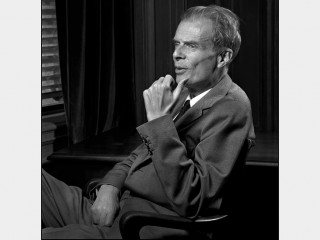
Aldous Leonard Huxley biography
Date of birth : 1894-07-26
Date of death : 1963-11-22
Birthplace : Godalming, Surrey, England
Nationality : British
Category : Famous Figures
Last modified : 2010-11-16
Credited as : Novelist and short stories writer, ,
The novels, short stories, and essays of the English author Aldous Leonard Huxley explore crucial questions of science, religion, and philosophy.
Aldous Huxley was born into a family of intellectual prominence. His father, Leonard, was the son of T. H. Huxley, the famous proponent of Darwinism when it was first finding acceptance; his mother, Julia, was the niece of the poet and critic Matthew Arnold. Aldous attended Eton on a scholarship and specialized in biology, intending to become a doctor, but he contracted keratitis and soon was almost blind. However, he learned to read Braille and continued his studies under tutors. When one eye recovered enough so that he could read with a magnifying glass, he turned to English literature and philosophy at Oxford, taking a degree in 1915.
After World War I Huxley engaged in literary journalism and was on the staff of the Athenaeum, edited by John Middleton Murry. For the greater part of 1923-1930 he lived in Italy; after 1926 he spent much time there with D. H. and Frieda Lawrence. Lawrence was a strong influence on Huxley, particularly in his mistrust of intellect and trust in vital promptings.
Huxley's early period was characterized by skeptical, brilliant portraits of a decadent society. This was the period of the novels Crome Yellow (1921), Antic Hay (1923), and Point Counter Point (1928), in which the characterizations of D. H. and Frieda Lawrence as the Mark Rampions are practically the only favorable ones. Huxley's disgust with much of the modern world became explicit in Brave New World (1932) and Eyeless in Gaza (1936).
In 1938 Huxley encountered the Bates method of eye training and moved to southern California, where facilities for it were unusually good. He said of the method that it demonstrated in that particular sphere "the possibility of becoming the master of one's circumstances…. Similar techniques for controlling other unfavorable circumstances have been independently developed…. All these techniques, however, are secondary … to a great central technique. This central technique, which teaches the art of obtaining freedom from the fundamental human disability of egotism, has been repeatedly described by the mystics of all ages and countries. It is with the problem of personal, psychological freedom that I now find myself predominantly concerned."
Huxley's The Perennial Philosophy (1945) was in a sense a documentation of this statement. Through its initial statement of somatic psychology, it illustrated well the modern interest in psychological necessity. But Huxley's most famous dramatization of the possibility of dehumanizing kinds of control through the use of conditioning, drugs, and economic necessity was Brave New World. In a sequel, Brave New World Revisited, he considered ways of solving the threat of the so-called population explosion.
Huxley's "mystical" phase is linked to his long association with Gerald Heard. Huxley's most successful later work was The Devils of Loudon (1952), which dealt with the hysteria that swept a French Ursuline convent in the 17th century and the martyrdom of a priest. All along, of course, Huxley had shown interest in any means of liberation from the bondage of the ego, and his The Doors of Perception (1954), dealing with the drug mescaline, can be seen as an interesting anticipation of the interest more than a decade later in the psychedelic experience. He said that he had helped his wife, Maria, die by using the medieval Ars moriendi, and it is said that while he was dying, his mind was "liberated" by drugs.
Of Huxley's general direction, Charles J. Rolo (1947) said: "When Huxley came of age, human behavior, it seemed to the modernist, was entirely explicable in terms of Libido, Instinct, glandular function or conditioned reflex…. While repudiating the Gods and Goods, Huxley implicitly continued to search for them, applying to the task an integrity that bit like acid through illusion, sentimentality and convention. All his work is a quest for values in the face of scepticism." Jocelyn Brooke (1954) found Huxley, "despite the homogeneity of his writings …, a strangely paradoxical figure: an intellectual who profoundly distrusts the intellect, a sensualist with an innate loathing for the body, a naturally religious man who remains an impenitent rationalist."
A good introduction and survey is The World of Aldous Huxley: An Omnibus of His Fiction and Non-fiction over Three Decades, edited with an introduction by Charles J. Rolo (1947). A brief survey of Huxley's career is in Jocelyn Brooke, Aldous Huxley (1954). See also David S. Savage, Mysticism and Aldous Huxley: An Examination of Heard-Huxley Theories (1947), and the essay by M. Lebowitz in John Crowe Ransom, ed., The Kenyon Critics: Studies in Modern Literature from the Kenyon Review (1951). Other studies of Huxley include John A. Atkins, Aldous Huxley: A Literary Study (1956; rev. ed. 1967); Julian S. Huxley, ed., Aldous Huxley, 1894-1963: A Memorial Volume (1965); and Laura Archera Huxley, The Timeless Moment: A Personal View of Aldous Huxley (1968).
















